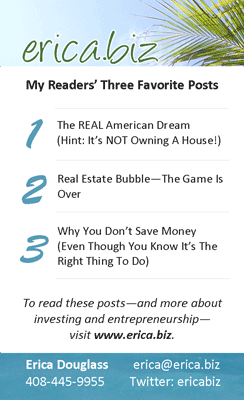Are Your Business Cards Still Stuck In The 1990's?
It’s interesting how a single sentence in a conversation can completely change your perspective.
After I sold Simpli Hosting, I realized I needed new business cards. I had just redesigned erica.biz, so I did a quick mockup business card (below) and ran with it. I then got wrapped up in blogging and finishing up everything at Simpli, and I forgot about getting “actual” business cards. My temporary cards and I arrived at South by Southwest, where I bumped into Robert Scoble.

I know famous bloggers like Robert Scoble aren’t supposed to even be approachable, but I found Robert to be open and friendly. He was happy to give advice on my upcoming projects, but the most valuable piece of advice he gave me had nothing to do with my personal projects. One sentence that Robert said completely changed the way I thought about business cards. After you see how it changed my perspective, perhaps you’ll consider changing your business cards as well. It may well be one of the most valuable decisions you will make.
Robert said, “A business card that causes a conversation is more memorable.” He then went on to explain that he received thousands of business cards. He keeps most of them, he said, because he regularly is on the lookout for new and interesting people to interview.
A Card That Causes A Conversation Is Critical
Why is it so important for your business card to stand out? Because when someone you want to communicate with in the future–like Robert Scoble–is going through that stack of 500 business cards he just received at a huge event, to reach out to people in the future, he may not remember just a name and generic job title. This is critical for someone like Robert, who is inundated with requests for interviews.
Granted, this isn’t the first time Robert has relayed this advice. In fact, he wrote a whole blog entry about “best business card practices” in 2006. But since I’m one of those folks who learns by example, I wanted to explain how I put Robert’s best practices into action — and add some best practices of my own.
Your Four Steps to Business Card Bliss
- Think about what objectives you are trying to accomplish with your business card. Your objective can’t be a bland “I want people to have my contact information.” Turn this around and think of it as marketing. Can your prospects gain value from your business card? Can you give them something to think about? I equate the challenge of delivering value on a business card to delivering value in a 140-character message on Twitter. Both have the following constraint, which presents a unique challenge: How do you present what you are doing as succinctly as possible, and at the same time start a conversation about it so that other people can participate?
I decided that my business card objective would be to drive people to my blog. My blog has great samples of my writing style, my contact information, and public speaking information so that people know that I speak at conferences. Instead of writing on my card “writer/entrepreneur” (which is what I did before), I decided to give samples of my writing. Since I had recently installed the “Popularity Contest” plugin for WordPress and placed my most popular posts on my blog sidebar, I continued the theme by listing three popular blog post titles on my business card. Here’s how it turned out:

- MOST IMPORTANT: Put a call to action on your business card! This goes with your objective above. Since my objective was to get more people to visit, read, and subscribe to my blog, I wrote “To read these posts –and more about investing and entrepreneurship–visit www.erica.biz.” after listing my blog posts. The three blog posts I listed are the most popular on my blog as voted by my visitors. You are either interested in the subject matter or you’re not. Either way, I quickly either draw a new reader into my blog or a get an “eh, so what?” reaction. The important thing is that I have made my prospect think (and potentially comment, either to me or on my blog.)
- Consider what contact information is most appropriate. I decided not to put a title on my business card. I have completely abandoned “writer/entrepreneur” because it’s so boring. Instead, I just put my name, my phone number, my email address, and–as a new experiment–my Twitter account.
Robert wrote his original blog post about business cards in 2006, before Twitter was huge, so I would be interested to hear his opinion on using Twitter on a business card now. Twitter is most often how I connect with people I have met at a conference because it allows me a view into their lives, the ability to help them solve problems, and an ability to private message them when I need to talk.
- Consider what “fancy stuff” you need. Unlike Robert, I don’t believe you necessarily need fancy die-cut, rounded corner, transparent business cards. Those business cards may start a conversation at the conference, but they won’t necessarily help me remember you when I get home.
Like Robert, I do think having your picture is a useful addition to a business card. Although I did not put my picture on my new business cards, I think it is worth doing, especially if you have a “brandable” face.
I didn’t do anything super-fancy; I got my cards nicely printed on gloss paper at PsPrint. One of the things I will have to do is change my business cards frequently as I have more popular posts. This makes for an interesting conversation tool in and of itself — “Won’t you have to change these all the time?” was the most common question I received when I showed the card proofs to my friends. I like the idea of having “dynamic” business cards. It cost me about $27 to have 250 business cards printed and shipped to my door, so changing them every 3 months is not a major expense, and it keeps things interesting.
With these four ideas in mind, you can create your own version of “business card bliss.” The final thing I will add is: don’t be afraid to experiment! I certainly got some negative feedback for this set of cards. The initial feedback helped me change several pieces of the cards before I sent them off to be printed. Of course, I welcome your feedback in the comments as well!
PsPrint offers a 50-card small run for just $4.95 + shipping, so what do you have to lose? Experiment! Do “split testing” — create multiple cards and see which ones work better. Which cards create more of an impression? Which cards do people comment on more? Don’t be scared by a small amount of negative feedback, either…it’s more important to get a reaction than to get a shrug and a bored look.
An Example of an “Experimental” Business Card That Worked
A great example of the above is one of the business cards that Darren Rowse of Problogger received at SXSW. He shows it off in his How To Promote Yourself (And Your Blog) At A Conference videoblog. It’s a guy who wrote a completely silly (and quite detailed!) story about how he forgot his business cards and had to quickly create new cards “in romantic old school fashion”. He wrote all of this on a business card and handed them out at SXSW. Whether intentional or not, it was brilliant marketing, and Darren remembered his card enough to feature it on Problogger. This guy’s experiment paid off!
Your business cards are an excellent chance to build up readers, a client base, or whatever else you want. By having a clear objective and following through with a card that starts a conversation, you can’t go wrong.
Cheers to Robert Scoble for giving me this idea!


